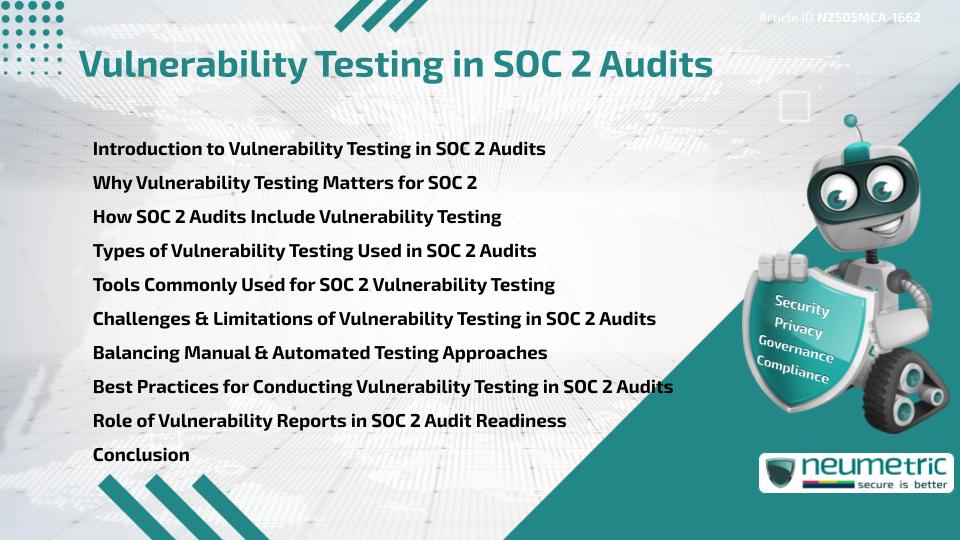Table of Contents
ToggleIntroduction to Vulnerability Testing in SOC 2 Audits
Vulnerability Testing in SOC 2 Audits plays a critical role in identifying Risks that could impact the Security & Privacy of Customer Data. SOC 2 or System & Organisation Controls 2, is a widely recognised Auditing Standard for Service Organisations, especially those that handle sensitive information.
This article explains how Vulnerability Testing fits into SOC 2 Audits, why it matters & how Organisations can implement it effectively to meet Compliance needs.
Why Vulnerability Testing Matters for SOC 2
SOC 2 Audits focus on five (5) Trust Services Criteria: Security, Availability, Processing Integrity, Confidentiality & Privacy. Of these, Security is the foundation & Vulnerability Testing helps verify it.
Without testing for flaws in Applications, Systems or Networks, Service Providers cannot reasonably assure Auditors or Clients that their Controls are effective. This makes Vulnerability Testing in SOC 2 Audits a cornerstone for meeting Security expectations.
According to the American Institute of Certified Public Accountants (AICPA), Organisations must show that their Security Controls are not just documented but operational. Vulnerability Testing validates that reality.
How SOC 2 Audits Include Vulnerability Testing
SOC 2 Audits don’t mandate specific tools or actions, but they require evidence of strong Controls. Vulnerability Testing supports that evidence by:
- Uncovering exploitable weaknesses in infrastructure
- Demonstrating remediation steps taken to close Security Gaps
- Supporting Risk Assessments that align with the Security criteria
Auditors review testing results to determine whether Control objectives are achieved. So Vulnerability Testing in SOC 2 Audits acts as both a preventive & detective measure in the Compliance journey.
Types of Vulnerability Testing Used in SOC 2 Audits
Organisations may use various testing types to support their Audit requirements. These typically include:
- Network Vulnerability Scans: Check for weaknesses in Servers, Firewalls or Routers.
- Web Application Testing: Look for flaws like SQL injection or Broken Authentication.
- Internal Security Testing: Focuses on Internal Systems & User Access.
- Configuration Reviews: Ensures Systems are set up securely.
Combining these approaches makes Vulnerability Testing in SOC 2 Audits more comprehensive & credible.
Tools Commonly Used for SOC 2 Vulnerability Testing
There are many tools available that simplify & automate this testing. Popular examples include:
- Nessus: Ideal for scanning networks for Vulnerabilities.
- OpenVAS: An open-source scanner with wide plugin support.
- Burp Suite: Excellent for Web Application Testing.
- Qualys: Offers Cloud-based Asset Discovery & Scanning.
Using these tools, teams can schedule regular tests & export Reports, which help during Audit walkthroughs. The Center for Internet Security (CIS) offers guidance on Secure Configurations & Testing Tools that align with industry norms.
Challenges & Limitations of Vulnerability Testing in SOC 2 Audits
While testing is essential, it’s not without issues. Common limitations include:
- False Positives: Tools may detect Vulnerabilities that are not exploitable.
- Tool Limitations: Not all tools scan for zero-day Vulnerabilities.
- Lack of Context: Automated Scans can miss Risks tied to business logic.
- Human Error: Manual tests depend on tester skills & experience.
Vulnerability Testing in SOC 2 Audits is only as effective as the process behind it. Blindly trusting the results without analysis could lead to missed Risks.
Balancing Manual & Automated Testing Approaches
Automated Scans are fast & repeatable, but Manual Testing adds context & depth. For example:
- Automation handles broad scans across multiple systems quickly.
- Manual Testing explores complex issues like chained Vulnerabilities or misconfigured Identity Controls.
Together, they create a strong foundation for Security assurance. As OWASP explains, a hybrid model is often most effective for real-world application testing.
Vulnerability Testing in SOC 2 Audits Best Practices
To ensure success, Organisations should:
- Test regularly, not just before the Audit period.
- Document all Findings & Fixes for review by Auditors.
- Use a testing schedule aligned with change management cycles.
- Verify remediation through retesting.
- Engage trained testers to handle both internal & external reviews.
Following these steps improves Audit outcomes & reduces the Risk of failing key Controls.
Role of Vulnerability Reports in SOC 2 Audit Readiness
The final step in Vulnerability Testing in SOC 2 Audits is the reporting. A good report will:
- Describe Vulnerabilities by Risk level
- Include screenshots or logs for evidence
- Show remediation status
- Explain how the issue was discovered
Auditors use these reports as supporting documents. The National Institute of Standards & Technology (NIST) provides a National Vulnerability Database that helps classify Risks & adds value to internal reporting efforts.
Takeaways
- Vulnerability Testing is essential for meeting the Security criteria in SOC 2 Audits.
- It includes both automated tools & manual checks.
- Testing must be documented, repeatable & reviewed.
- Reports from testing help demonstrate Control effectiveness.
- Best Practices improve Audit outcomes & enhance organizational Security.
Conclusion
Vulnerability Testing in SOC 2 Audits is not just a Compliance requirement but a practical defense against real Threats. It helps businesses identify weak spots in their systems, understand how attackers might exploit them & take timely Corrective Action. For Service Organisations, this process proves their commitment to protecting Client data & maintaining trust. While it demands time & technical effort, the payoff in Risk reduction & regulatory readiness is significant. When done well, it contributes directly to a successful SOC 2 Audit & a more resilient Security posture.
FAQ
What is the purpose of Vulnerability Testing in SOC 2 Audits?
It identifies weaknesses in Systems or Applications to ensure Controls are effective & meet SOC 2 Security requirements.
Are Vulnerability scans mandatory for SOC 2 Compliance?
While not explicitly required, they are often expected by Auditors as part of evidence for effective Security Controls.
What tools are best for Vulnerability Testing in SOC 2 Audits?
Common tools include Nessus, OpenVAS, Burp Suite & Qualys, which provide scanning & reporting features.
How often should Vulnerability Testing be done for SOC 2?
Testing should be done regularly, ideally monthly or quarterly & whenever there are major system changes.
Can Vulnerability Testing alone guarantee SOC 2 Compliance?
No, it supports Compliance but must be combined with documented Policies, Access Controls & monitoring.
What is the difference between Vulnerability Assessment & Penetration Testing?
Scanning identifies known flaws, while Penetration Testing exploits them to test how systems respond under real attack conditions.
Should internal systems be tested during SOC 2 Audits?
Yes, internal systems often store or transmit Sensitive Data & must be tested like public-facing systems.
How do Auditors use Vulnerability test results?
They review reports to confirm that Vulnerabilities were identified, Risk-ranked & properly addressed before issuing the SOC 2 Report.
References
- American Institute of Certified Public Accountants (AICPA)
- OWASP Web Security Testing Guide
- Center for Internet Security (CIS)
- National Vulnerability Database (NIST)
- SQL Injection Explanation by OWASP
Need help?
Neumetric provides organisations the necessary help to achieve their CyberSecurity, Compliance, Governance, Privacy, Certifications & Pentesting goals.
Organisations & Businesses, specifically those which provide SaaS & AI Solutions, usually need a CyberSecurity Partner for meeting & maintaining the ongoing Security & Privacy needs & requirements of their Clients & Customers.
SOC 2, ISO 27001, ISO 42001, NIST, HIPAA, HECVAT, EU GDPR are some of the Frameworks that are served by Fusion – a centralised, automated, AI-enabled SaaS Solution created & managed by Neumetric.
Reach out to us!


